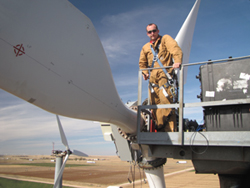
ALBUQUERQUE, N.M. — Researchers with Sandia National Laboratories and Purdue University are using sensors and computational software to help design a better wind turbine.
The sensors are being placed on experimental turbines in Bushland, Texas, to provide enhanced capabilities to monitor and control the wind turbines. A team from both institutions presented research on the topic in a paper at the Windpower 2009 Conference and Exhibition held in Chicago in early May.
“Excessive loads on wind turbines can cause damage to components, which can then lead to costly repairs or even catastrophic failure in some circumstances,” says Josh Paquette, one of the Sandia engineers who worked on the project. “We are investigating how an accelerometer system can help determine blade motions and structural health, and allow for operational modifications to avoid damage.”
The accelerometer systems consist of sensors and computational software that constantly monitor forces exerted on wind turbine blades. They measure two types of acceleration: those due to varying winds and those caused by gravity and rotation. It is essential to accurately measure and separate both sources of acceleration to estimate forces exerted on the blades.
Purdue is under contract with Sandia to help develop the technology. The two institutions are using the sensors to monitor turbines in real time to determine the wind pressure on the blades. That information is then fed into the turbine’s control system.
The sensor research, says Jose Zayas, manager of the Sandia’s Wind Energy Technology Department, has been conducted on Sandia-owned sub-scale experimental-size blades in Bushland. The results will then be extrapolated to full-size machines.
“This work is important because as more wind power is deployed, it is essential to continue to develop innovations that improve the technology and protect the capital investments,” Zayas says. “Each utility-scale machine costs in the range of $2 million to 4 million and damaged components could lead to the loss of entire machines.”
Wind power is becoming a more prevalent part of the U.S. energy portfolio, Zayas notes. As of the end of 2008 some 25 gigawatts of wind energy had been installed nationwide. Also, in 2008 — for the second year in a row — wind energy accounted for approximately 40 percent of all new energy in the United States.
A wind turbine’s major components include rotor blades, a gearbox, and generator. The wind turbine blades are made primarily of fiberglass and balsa wood or foam, and occasionally are strengthened with carbon fiber.
“The aim is to operate the generator and the turbine in the most efficient way, but this is difficult because wind speeds fluctuate, says Doug Adams, a professor of mechanical engineering and director of Purdue’s Center for Systems Integrity. “You want to be able to control the generator or the pitch of the blades to optimize energy capture by reducing forces on the components in the wind turbine during low winds. In addition to improving efficiency, this should help improve reliability.”
Zayas calls the joint research between Sandia and Purdue “a perfect partnership between a national laboratory and academic institution.”
“It shows how the two can work together and collaborate to improve industry,” he says.